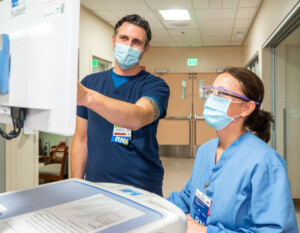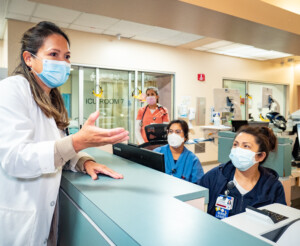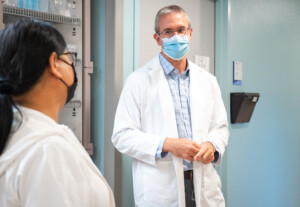Main story: With vaccinations, COVID-19 cases decline
Doctors and nurses at South Valley hospital are ‘cautiously optimistic’
![]()

Photo courtesy Nick Sherrell
St. Louise Regional Hospital executive Gloria Dela Merced speaks to staff members.
By Kelly Barbazette
After a year and a half on the front lines treating patients for COVID-19, doctors and nurses at St. Louise Regional Hospital say the worst of the third and latest surge of the pandemic is beginning to recede, with cases hovering in the single digits.
“As of this morning (Sept. 17), we have five cases. We’re definitely moving in the right direction,” said Dr. Scott Ahlbrand, who has worked for Santa Clara County as an anesthesiologist and Intensive Care Unit doctor for the past 13 years and is the current interim physician executive for St. Louise Regional Hospital.
 St. Louise Regional Hospital, O’Connor Hospital, and Santa Clara Valley Medical Center report a total of 22 patients testing positive for COVID-19 across the three facilities as of Sept. 30.
St. Louise Regional Hospital, O’Connor Hospital, and Santa Clara Valley Medical Center report a total of 22 patients testing positive for COVID-19 across the three facilities as of Sept. 30.
While case numbers are going in the right direction, doctors and nurses say they are cautiously optimistic, recognizing that COVID cases could begin to climb again in an instant.
“We’ve turned the corner before and then Delta (variant) came. Until we have a higher number of our community vaccinated, we have a chance of another variant coming in and it happening again,” Ahlbrand said.
In the past few weeks, St. Louise has experienced a 75 percent reduction of COVID patients, dropping from about 20 cases to five.
“This is the lowest number we’ve had in quite some time especially since the latest surge,” said Ahlbrand, whose duties include maintaining the hospital’s quality standards, expanding services, and optimizing patient care.
 St. Louise, the smallest hospital in the county, typically has 20 or 30 patients at one time, he said. But that number toggled between 40 and 60 in the past couple of months, about half of whom tested positive for COVID and the other half comprised of patients who had prolonged seeing a doctor because of the pandemic.
St. Louise, the smallest hospital in the county, typically has 20 or 30 patients at one time, he said. But that number toggled between 40 and 60 in the past couple of months, about half of whom tested positive for COVID and the other half comprised of patients who had prolonged seeing a doctor because of the pandemic.
“A month or two ago, we had a peak from the last surge, but during the past few weeks it has gone down,” he said. “What’s interesting is the patients who are admitted and do get quite sick are unvaccinated. We have very few COVID patients who are vaccinated.”
Tyler Johnston, RN, assistant nurse manager for St. Louise, describes the past few months as a roller-coaster. As COVID cases began to drop with the roll-out of local vaccination clinics, staff began to feel hopeful. But with the Delta variant triggering a third surge beginning in August, Johnston said it began to feel like “Groundhog Day.”
“The feeling was, not this again,” he said. “Discouragement and a little bit of frustration, I guess, because there’s so much information about the health benefits of the vaccinations and masking, and yet the numbers started going back up.”
 With the latest surge of cases, he noted COVID patients in the ICU were much younger than in previous waves of the pandemic.
With the latest surge of cases, he noted COVID patients in the ICU were much younger than in previous waves of the pandemic.
“That was definitely harder. The staff was affected much more emotionally than previous waves,” he said.
Even as numbers declined, challenges at St. Louise continue to be two-fold: ensuring the hospital is sufficiently staffed and preventing burn-out.
While the hospital is able to provide sufficient staff to patient ratio and appropriate patient care, Ahlbrand said, the hospital doesn’t have as deep of a reserve pool as it would like. A sick child at home means a doctor or nurse can’t come into work. And a lack of traveling nurses, who frequently choose states and hospitals with higher wages, led to a greater number of staff working 16-hour shifts, Johnston said.
 “It’s a competitive market. They’re going to follow the money,” he said. “We did have to rely on our staff a lot more. That played into the burnout. Luckily, numbers are starting to go back down, so I’m cautiously optimistic.”
“It’s a competitive market. They’re going to follow the money,” he said. “We did have to rely on our staff a lot more. That played into the burnout. Luckily, numbers are starting to go back down, so I’m cautiously optimistic.”
St. Louise didn’t experience significant attrition from the nursing staff. A few left during the pandemic due to retirement and relocation, Ahlbrand said.
He credits the resiliency of the community’s front line workers — both at the hospital and in the greater community — for pulling together and working as a team.
“Everyone is going above and beyond; all the doctors, nurses, and janitors. Going into a COVID room to clean it, that takes bravery and commitment. That’s something we haven’t seen waver and that’s really inspiring,” Ahlbrand said.
 Visiting vaccination clinics, like the one at Gilroy High School, has helped combat fatigue and lift staff’s spirits, Johnston said.
Visiting vaccination clinics, like the one at Gilroy High School, has helped combat fatigue and lift staff’s spirits, Johnston said.
“They get to see the opposite side of patient care. As opposed to seeing patients at their worst, they get to see them when they’re healthy and want to get vaccinated,” he said.
Connecting with patients’ families while holding up iPads and assisting with visits on Facetime or taking a break to eat lunch knowing that the meal was donated by a local restaurant or community organization have also helped boost morale, he said.
“Seeing the vaccination rates and seeing community members masking, it validates what we do now,” Johnston said. “This last wave, the patients we’re seeing aren’t vaccinated.”
Some 83 percent of Santa Clara County residents who are eligible are completely vaccinated. But that still leaves the remaining 17 percent — or more than 286,000 eligible county residents — unvaccinated.
“I’m hoping with our vaccination rates, we won’t get that spike after Thanksgiving, but it’s always in the back of my head, every time there’s a holiday,” Johnston said.
The county’s current decline in COVID-19 cases is reflective of the state’s downward trend. California has the lowest number of cases of any state. The state’s seven-day case rate is 95.3 per 100,000 people — less than half of neighboring states — as of Sept. 20, according to data from the U.S. Centers for Disease Control and Prevention. The region is faring better than the state as a whole. Santa Clara County’s seven-day rolling average of new cases is 232, according to the county’s COVID-19 dashboard.
But hospitalizations remain above where they were in May and June. And St. Louise doctors and nurses agree that more people becoming vaccinated is key to beating the pandemic.
“You don’t see a lot of black and white things in medicine, but the results you can see in this vaccine are so impressive — not only in the reduction of numbers, but also in the severity of the infections. It’s amazing,” Ahlbrand said.
Johnston agrees, saying the most important message to convey to the community is to get vaccinated.
“Follow the mask mandates. Get vaccinated. It’s safe, it’s been proven to be effective. If you do have concerns, talk to your health care provider rather than doing your own research,” he said. “There’s so much conflicting information out there. The vaccine has been politicized. Talk to your health care provider, they’re going to provide you with the facts, not just information based on opinion or politics.”
There are many opportunities to get vaccinated in Santa Clara County, including drop-in sites, same day appointments, and mobile and at-home services. Anyone 16 and older who lives, works, or attends school in Santa Clara County is eligible.
“It’s still here,” Johnston said. “There are people working to keep others alive. We are pleading with the community to do what they can to help us.”
